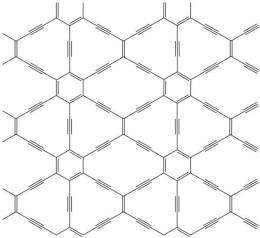March 5, 2012 report
Computer simulations suggest graphynes may be even more useful than graphene

(PhysOrg.com) -- The past several years have seen a virtual explosion in the amount of research dedicated to graphene and as a result there has been a nearly constant stream of news pertaining to new discoveries regarding its attributes. Now it appears, graphene is about to be upstaged by a more interesting cousin called graphyne. Graphene, as most everyone is aware by now, is a single layer of carbon atoms arranged in a hexagonal or chicken-wire pattern. Graphyne is also a single layer of carbon atoms, but it comes in several different types of patterns, which likely make it more versatile. Now new computer simulations regarding its properties have been done by a team of researchers in Germany, who report in Physical Review Letters, that their research shows that some types of graphyne structures allow for electron flow in just one direction.
Greaphene, it has been noted, has conduction electrons whose energies are directly proportional to their momentum. It has also been noted that when their energy levels are plotted in three dimensions, they take on the shape of a Dirac cone. Because of this unique relationship, the conduction electrons behave as if they were massless, allowing them to travel at very near the speed of light, a very useful property when looking to improve on such things as current transistor technology.
Unlike graphene, which has single or double bonds, graphyne can have double or triple bonds, and it’s not restricted to just a hexagonal pattern. Indeed the number of patterns that it can exist as appears to be almost limitless.
In this new research, the team looked at three graphyne pattern types with their computer simulation and found all of them capable of producing a Dirac cone, albeit in a slightly different shape; but perhaps most importantly, one of them called 6,6,12-graphyne, which exists as a pattern of rectangles, should allow electrons to travel in just one direction. Because of this, the researchers say, materials could be made that didn’t require “dopant” or nancarbon atoms to provide a source for the electrons, such as the case with graphene.
Despite the fact that only very small pieces of graphyne have ever been made, researchers are excited about this research because it has shown that many graphyne pattern types exist that are capable of producing a Dirac cone, which means many other materials may be capable of doing so as well.
More information: Competition for Graphene: Graphynes with Direction-Dependent Dirac Cones, Phys. Rev. Lett. 108, 086804 (2012) DOI: 10.1103/PhysRevLett.108.086804
Abstract
The existence of Dirac cones in the band structure of two-dimensional materials accompanied by unprecedented electronic properties is considered to be a unique feature of graphene related to its hexagonal symmetry. Here, we present other two-dimensional carbon materials, graphynes, that also possess Dirac cones according to first-principles electronic structure calculations. One of these materials, 6,6,12-graphyne, does not have hexagonal symmetry and features two self-doped nonequivalent distorted Dirac cones suggesting electronic properties even more amazing than that of graphene.
via Focus
Journal information: Physical Review Letters
© 2011 PhysOrg.com












.jpg)





